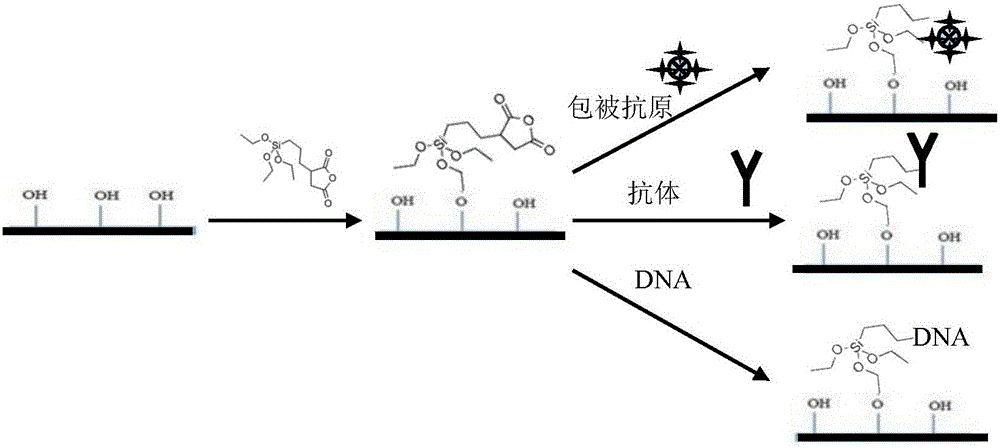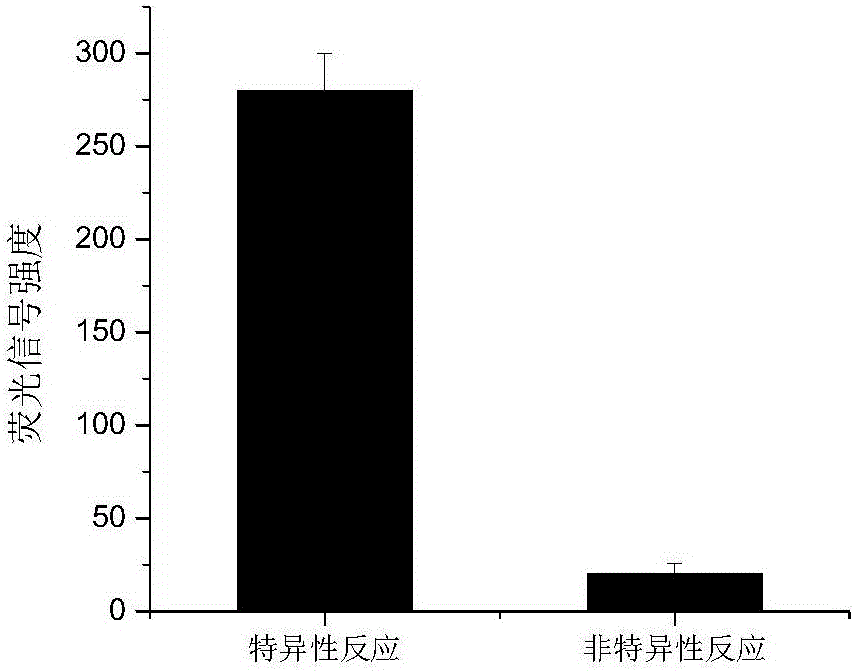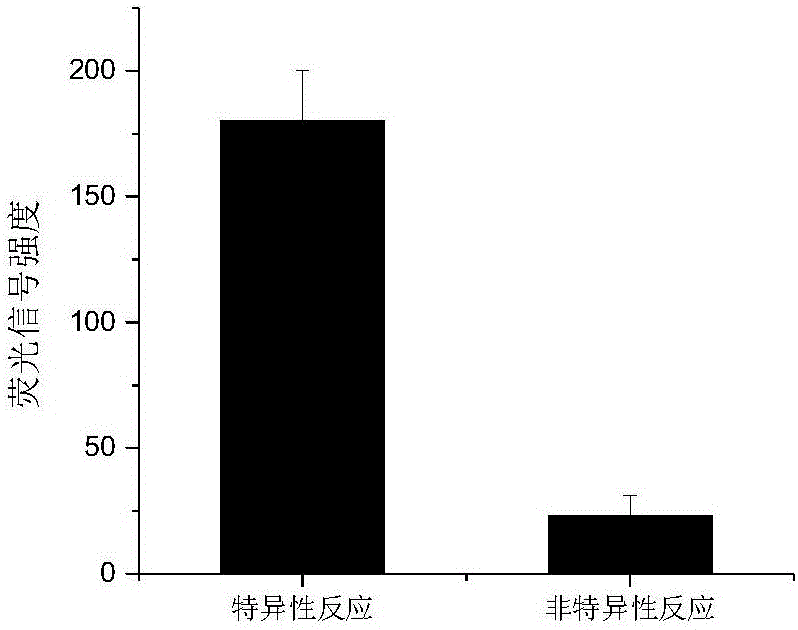Method for fixing biometric identification molecules to biochip
A biochip and biorecognition technology, applied in chemical instruments and methods, analytical materials, laboratory containers, etc., can solve the problems of reduced activity of biorecognition molecules, reduction of bioanalysis technology performance, and hindrance of biomolecular affinity , to achieve the effect of avoiding non-specific adsorption, compact structure and uniform distribution
- Summary
- Abstract
- Description
- Claims
- Application Information
AI Technical Summary
Problems solved by technology
Method used
Image
Examples
Embodiment 1
[0052] Example 1 directly immobilizes the coated antigen on the surface of the biochip:
[0053] This example takes Microcystin-LR coated antigen (MC-LR-OVA) as an example, Microcystin-LR coated antigen was purchased from Sigma-al (China), according to figure 1 The schematic diagram of the immobilization process on the surface of the biochip is shown as follows:
[0054] 1) First use Piranha solution (concentrated H 2 SO 4 and H 2 o 2 The volume ratio is 3:1) at 25°C to clean the surface of the biochip (quartz glass sheets on the market, with a size of 1cm×1cm) for 30min to remove organic matter on the surface and to hydroxylate the surface; then Then put it into an ultrasonic cleaner and wash it thoroughly with ultrapure water until the pH value of the cleaning solution is neutral. Finally, dry it with nitrogen at room temperature, put it in a drying oven at 105°C for 2 hours, and then store it in Reserved in a vacuum drying oven;
[0055] 2) Put the clean surface hydro...
Embodiment 2
[0059] Embodiment 2 directly immobilizes the antibody on the surface of the biochip:
[0060] This example takes the bisphenol A antibody as an example. The bisphenol A antibody was purchased from Beijing Jinda Qingchuang Environmental Technology Co., Ltd., according to figure 1 The schematic diagram of the immobilization process on the surface of the biochip is shown as follows:
[0061] 1) First use Piranha solution (concentrated H 2 SO 4 and H 2 o 2 The volume ratio is 3:1) at 25°C to clean the surface of the biochip (quartz glass sheets on the market, with a size of 1cm×1cm) for 30min to remove organic matter on the surface and to hydroxylate the surface; then Then put it into an ultrasonic cleaner and wash it thoroughly with ultrapure water until the pH value of the cleaning solution is neutral. Finally, dry it with nitrogen at room temperature, put it in a drying oven at 105°C for 4 hours, and store it in Reserved in a vacuum drying oven;
[0062] 2) Put the clean ...
Embodiment 3
[0066] Example 3 DNA fragments are directly immobilized on the surface of the biochip:
[0067] The DNA fragment is: 5'-NH 2 -TTTTTTTTTT-3' (provided by Sangon Bioengineering (Shanghai) Co., Ltd.), according to figure 1 The schematic diagram of the immobilization process on the surface of the biochip is shown as follows:
[0068] 1) First use Piranha solution (concentrated H 2 SO 4 and H 2 o 2 The volume ratio is 3:1) at 25°C to clean the surface of the biochip (quartz glass sheets on the market, with a size of 1cm×1cm) for 30min to remove organic matter on the surface and to hydroxylate the surface; then Then put it into an ultrasonic cleaner and wash it thoroughly with ultrapure water until the pH value of the cleaning solution is neutral. Finally, dry it with nitrogen at room temperature, put it in a drying oven at 105°C for 3 hours, and store it in Reserved in a vacuum drying oven;
[0069] 2) Put the clean surface hydroxylated biochip into 2% dihydro-3-[3-(triethox...
PUM
 Login to View More
Login to View More Abstract
Description
Claims
Application Information
 Login to View More
Login to View More - R&D
- Intellectual Property
- Life Sciences
- Materials
- Tech Scout
- Unparalleled Data Quality
- Higher Quality Content
- 60% Fewer Hallucinations
Browse by: Latest US Patents, China's latest patents, Technical Efficacy Thesaurus, Application Domain, Technology Topic, Popular Technical Reports.
© 2025 PatSnap. All rights reserved.Legal|Privacy policy|Modern Slavery Act Transparency Statement|Sitemap|About US| Contact US: help@patsnap.com



